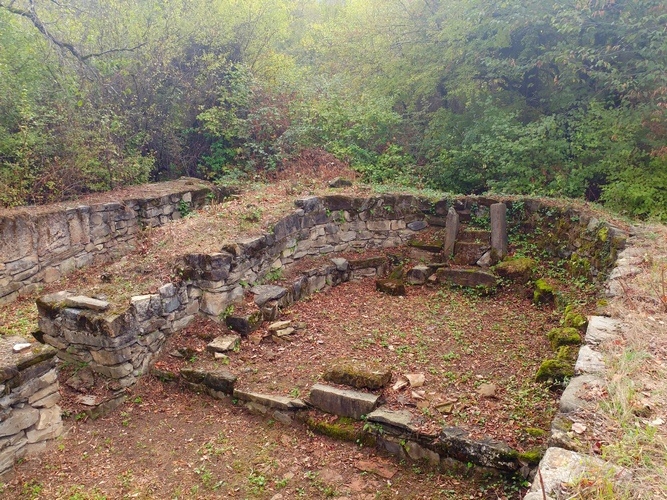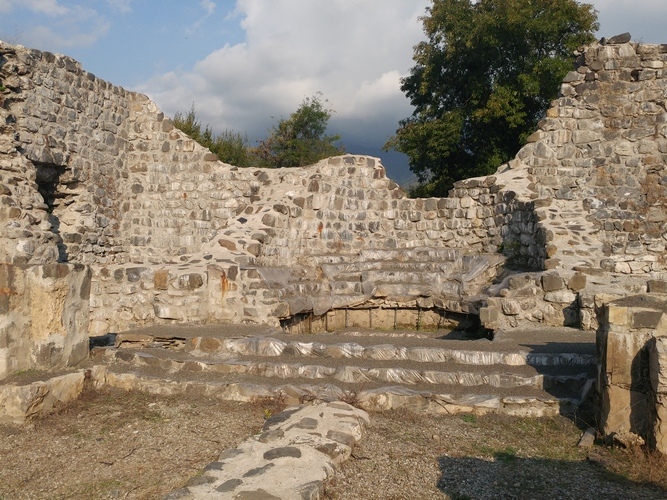|
Nekresi
Nekresi ( ka, ნეკრესი) is a historic and archaeological site in eastern Georgian region of Kakheti, between the town of Qvareli and the village of Shilda, at the foothills of the Greater Caucasus mountains. It is home to the still-functioning Nekresi monastery, founded in the 6th century. Nekresi is known from the early medieval Georgian sources as a once flourishing town of Antiquity. A series of archaeological expeditions, beginning in 1984, have uncovered various features of a large settlement, but its extents remain unknown owing to a densely forested landscape and lack of written sources. Several major structures, unearthed across the site and mostly dated to the Late Antiquity, bear traces of earthquakes and violent destruction. Nekresi was reduced to a village or a number of hamlets in the 8th century. Its principal monastery remained functional, but the town itself became engulfed in foliage and gradually disappeared from historical memory until its redisco ... [...More Info...] [...Related Items...] OR: [Wikipedia] [Google] [Baidu] |
Nekresi
Nekresi ( ka, ნეკრესი) is a historic and archaeological site in eastern Georgian region of Kakheti, between the town of Qvareli and the village of Shilda, at the foothills of the Greater Caucasus mountains. It is home to the still-functioning Nekresi monastery, founded in the 6th century. Nekresi is known from the early medieval Georgian sources as a once flourishing town of Antiquity. A series of archaeological expeditions, beginning in 1984, have uncovered various features of a large settlement, but its extents remain unknown owing to a densely forested landscape and lack of written sources. Several major structures, unearthed across the site and mostly dated to the Late Antiquity, bear traces of earthquakes and violent destruction. Nekresi was reduced to a village or a number of hamlets in the 8th century. Its principal monastery remained functional, but the town itself became engulfed in foliage and gradually disappeared from historical memory until its redisco ... [...More Info...] [...Related Items...] OR: [Wikipedia] [Google] [Baidu] |
Nekresi Fire Temple
The Nekresi fire temple ( ka, ნეკრესის ცეცხლის ტაძარი, tr) is an archaeological complex in the eastern Georgian region of Kakheti, part of the wider Nekresi site. The excavated building, preserved only fragmentarily at a foundation level, is identified as a Zoroastrian fire temple, sun temple, or a Manichean shrine. Constructed in the 2nd or 3rd century, the complex was destroyed in the 5th. The site is inscribed on the list of the Immovable Cultural Monuments of National Significance of Georgia. History The Nekresi temple lies in lowland arable fields to the south of the hill on which the early medieval Nekresi monastery stands. It was unearthed by an archaeological expedition from the Georgian National Museum working at Nekresi between 1984 and 1993 and identified by its excavator, Levan Chilashvili, as a Zoroastrian fire-temple. In 2004, another team suggested that the temple was aligned with the summer and winter solstices and it ... [...More Info...] [...Related Items...] OR: [Wikipedia] [Google] [Baidu] |
Qvareli Municipality
Qvareli ( ka, ყვარლის მუნიციპალიტეტი) is an administrative-territorial unit in eastern Georgia, in the northeastern part of the Kakheti region. Until 1917, the territory of Qvareli Municipality was included in Telavi Mazra of Tbilisi Governorate; with the administrative division of 1921, the territory of Qvareli Municipality was again assigned to Telavi Mazra. Since 1930, it has been formed as a separate district. Currently, it is a municipality. The city of Qvareli, located at the confluence of the Bursa and Duruji rivers, has been a city since 1964. Area: 1000,8 km2. History Historical sources and archaeological field investigations have confirmed that there were ancient settlements in the territory of Qvareli municipality. At the State Museum of Academician Simon Janashia, archaeological items found in the area of present-day Shielda and Enisli, which belong to the Late Bronze Age, are preserved, and in the territory of Old Gavazi (no ... [...More Info...] [...Related Items...] OR: [Wikipedia] [Google] [Baidu] |
Chabukauri Basilica
Chabukauri basilica ( ka, ჭაბუკაურის ბაზილიკა, tr) is an early Christian church—now in a ruinous state—in the eastern Georgian region of Kakheti, in the territory of the historical settlement of Nekresi, about 1.5 km northwest of the Nekresi monastic complex. It is a large three-aisle basilica, dated to the 4th to 5th century, making it one of the earliest Christian church buildings in Georgia. It was unearthed in 1998. The basilica is inscribed on the list of the Immovable Cultural Monuments of National Significance of Georgia. History The Chabukauri basilica was unearthed in an eponymous plot in 1998 and was dated, on architectural and archaeological grounds, to the 4th or 5th century. Being one of the largest basilican churches in Georgia, its discovery questioned a previous assumption that the first church buildings in eastern Georgia were typically small narrow edifices autonomously developed in the country. Another huge basilica, the ... [...More Info...] [...Related Items...] OR: [Wikipedia] [Google] [Baidu] |
Abibos Of Nekresi
Abibus of Nekressi ( ka, აბიბოს ნეკრესელი, tr) (fl. 6th century) was one of the thirteen Assyrian apostles of Georgia and the bishop of Nekresi who arrived in Georgia under the leadership of St. Ioane of Zedazeni (John of Zedazeni). He began his activity as bishop in a village which was located in the hills in the eastern region of Kakheti. According to the chronicle Life of Kartli, he was spreading Christianity not only among Georgians but also among the mountain tribes such as the Dagestani/Didoians, the ancient predecessors of modern Dagestan.Loosley Leeming, Emma (2018). "Architecture and Asceticism: Cultural Interaction between Syria and Georgia in Late Antiquity". ''Texts and Studies in Eastern Christianity'', Vol. 13. Brill. 2018, p. 44 At that time there was a dark period of Persian rule in eastern Georgia. The main religion of Persians was Zoroastrianism - worship of fire. St. Abibos is said to have doused a sacred Zoroastrian flame with w ... [...More Info...] [...Related Items...] OR: [Wikipedia] [Google] [Baidu] |
Dolochopi Basilica
Dolochopi basilica ( ka, დოლოჭოპის ბაზილიკა, tr) is an early Christian church—now in a ruinous state—in the eastern Georgian region of Kakheti, in the territory of the historical settlement of Nekresi. It is a large 5th-century triple basilica, built over an earlier ruined church, which is carbondated to AD 387, making it one of the earliest known Christian sites in Georgia. It was unearthed in 2012. The basilica is inscribed on the list of the Immovable Cultural Monuments of National Significance of Georgia. Location The Dolochopi basilica—so named after a long-abandoned village—stands in ruins at the northwest outskirts of the town of Qvareli, on the right bank of the Duruji river. Some 3.5 km west as the crow flies is the Nekresi monastery, and further 1 km west, lies the archaeological site of Chabukauri, boasting ruins of a large early Christian basilica, which shares many features with that of Dolochopi. The ruins at Dolochopi w ... [...More Info...] [...Related Items...] OR: [Wikipedia] [Google] [Baidu] |
Thirteen Assyrian Fathers
The Thirteen Assyrian Fathers ( ka, ათცამმეტი ასურელი მამანი, tr) were, according to Georgian church tradition, a group of monastic missionaries who arrived from Mesopotamia to Georgia to strengthen Christianity in the country in the 6th century. They are credited by the Georgian church historians with the foundation of several monasteries and hermitages and initiation of the ascetic movement in Georgia.Rapp, Stephen H. (2003), ''Studies in Medieval Georgian Historiography: Early Texts And Eurasian Contexts'', p. 321. Peeters Publishers, Lang, David Marshall (1956), ''Lives and Legends of the Georgian Saints'', pp. 81-83. London: Allen & Unwin The lives of the Assyrian Fathers are related in a cycle of medieval Georgian hagiographic texts and are unattested beyond these sources. Some of these vitae are formalities composed for an 18th-century synaxary, but four of them exist in original form, as well a metaphrastic version. The dating ... [...More Info...] [...Related Items...] OR: [Wikipedia] [Google] [Baidu] |
Radiocarbon Dating
Radiocarbon dating (also referred to as carbon dating or carbon-14 dating) is a method for determining the age of an object containing organic material by using the properties of radiocarbon, a radioactive isotope of carbon. The method was developed in the late 1940s at the University of Chicago by Willard Libby. It is based on the fact that radiocarbon () is constantly being created in the Earth's atmosphere by the interaction of cosmic rays with atmospheric nitrogen. The resulting combines with atmospheric oxygen to form radioactive carbon dioxide, which is incorporated into plants by photosynthesis; animals then acquire by eating the plants. When the animal or plant dies, it stops exchanging carbon with its environment, and thereafter the amount of it contains begins to decrease as the undergoes radioactive decay. Measuring the amount of in a sample from a dead plant or animal, such as a piece of wood or a fragment of bone, provides information that can be used to ca ... [...More Info...] [...Related Items...] OR: [Wikipedia] [Google] [Baidu] |
Aragvi River
The Aragvi ( ka, არაგვი) and its basin are in Georgia on the southern slopes of the Caucasus Mountains. The river is long, and its basin covers an area of . The ground strata are mostly sandstone, slate, and limestone. The Zhinvali Dam and its 130 MW hydro-electric power station generate much of Georgia's power, and its construction in 1986 formed the Zhinvali Reservoir, upon whose north-western shores rises Ananuri castle with its 17th-century Church of the Assumption. Confusion over name and course Given its etymology (see below; the word simply means "river"), the exact course of the Aragvi River is the source of some confusion. The river has several important tributaries, all called "aragvi": The Tetri Aragvi ("White Aragvi") flows from Gudauri down to the town of Pasanauri, where it is joined by the Shavi Aragvi ("Black Aragvi"), the main river of Gudamakari to the north-east. Together, these two rivers continue as, simply, "the Aragvi"; from Pasanauri ... [...More Info...] [...Related Items...] OR: [Wikipedia] [Google] [Baidu] |
Late Middle Ages
The Late Middle Ages or Late Medieval Period was the period of European history lasting from AD 1300 to 1500. The Late Middle Ages followed the High Middle Ages and preceded the onset of the early modern period (and in much of Europe, the Renaissance). Around 1300, centuries of prosperity and growth in Europe came to a halt. A series of famines and plagues, including the Great Famine of 1315–1317 and the Black Death, reduced the population to around half of what it had been before the calamities. Along with depopulation came social unrest and endemic warfare. France and England experienced serious peasant uprisings, such as the Jacquerie and the Peasants' Revolt, as well as over a century of intermittent conflict, the Hundred Years' War. To add to the many problems of the period, the unity of the Catholic Church was temporarily shattered by the Western Schism. Collectively, those events are sometimes called the Crisis of the Late Middle Ages. Despite the crises, the 14th ... [...More Info...] [...Related Items...] OR: [Wikipedia] [Google] [Baidu] |
Cyril Toumanoff
Cyril Leo Toumanoff (russian: Кирилл Львович Туманов; 13 October 1913 – 4 February 1997) was a Russian-born Georgian historian and genealogist who mostly specialized in the history and genealogies of medieval Georgia, Armenia, Iran and the Byzantine Empire. His works have significantly influenced the Western scholarship of the medieval Caucasus. Robert H. Hewsen. "In Memoriam: Cyril Toumanoff." ''Journal of the Society for Armenian Studies''. Vol. 8, 1995, 5–7. Family Cyril Toumanoff was born in Saint Petersburg into a family of the military officer of the Russian army. His father's ancestors came of the princely family of Tumanishvili (Tumanov) from Georgia,Rapp, Stephen H. (2003), ''Studies In Medieval Georgian Historiography: Early Texts And Eurasian Contexts'', p. 16. Peeters Bvba, .For the present investigation no single scholar's body of work has had a greater impact than that of Cyril Toumanoff (1913 -1997). Born in St. Peterburg of an old Armeno-Geor ... [...More Info...] [...Related Items...] OR: [Wikipedia] [Google] [Baidu] |
.jpg)



.jpg)
